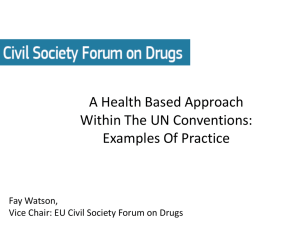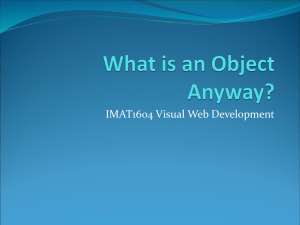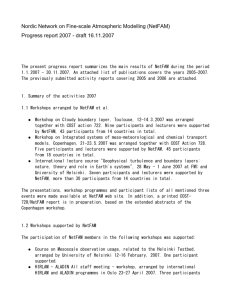NMR project: Validated models describing Nordic urban and
advertisement
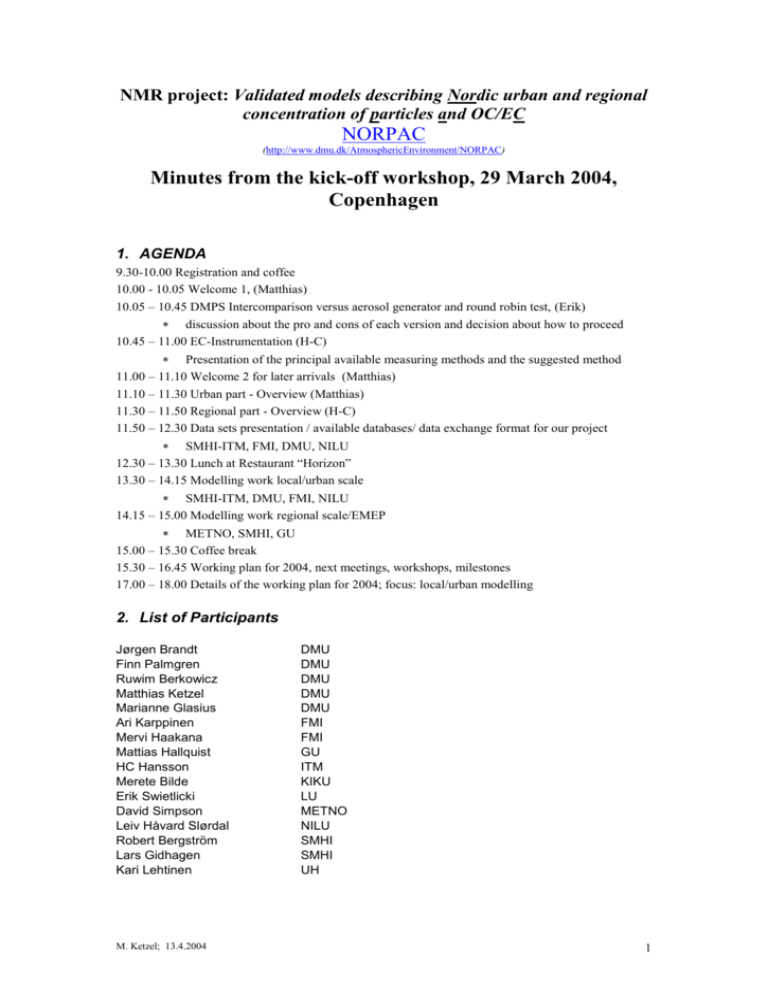
NMR project: Validated models describing Nordic urban and regional concentration of particles and OC/EC NORPAC (http://www.dmu.dk/AtmosphericEnvironment/NORPAC) Minutes from the kick-off workshop, 29 March 2004, Copenhagen 1. AGENDA 9.30-10.00 Registration and coffee 10.00 - 10.05 Welcome 1, (Matthias) 10.05 – 10.45 DMPS Intercomparison versus aerosol generator and round robin test, (Erik) discussion about the pro and cons of each version and decision about how to proceed 10.45 – 11.00 EC-Instrumentation (H-C) Presentation of the principal available measuring methods and the suggested method 11.00 – 11.10 Welcome 2 for later arrivals (Matthias) 11.10 – 11.30 Urban part - Overview (Matthias) 11.30 – 11.50 Regional part - Overview (H-C) 11.50 – 12.30 Data sets presentation / available databases/ data exchange format for our project SMHI-ITM, FMI, DMU, NILU 12.30 – 13.30 Lunch at Restaurant “Horizon” 13.30 – 14.15 Modelling work local/urban scale SMHI-ITM, DMU, FMI, NILU 14.15 – 15.00 Modelling work regional scale/EMEP METNO, SMHI, GU 15.00 – 15.30 Coffee break 15.30 – 16.45 Working plan for 2004, next meetings, workshops, milestones 17.00 – 18.00 Details of the working plan for 2004; focus: local/urban modelling 2. List of Participants Jørgen Brandt Finn Palmgren Ruwim Berkowicz Matthias Ketzel Marianne Glasius Ari Karppinen Mervi Haakana Mattias Hallquist HC Hansson Merete Bilde Erik Swietlicki David Simpson Leiv Håvard Slørdal Robert Bergström Lars Gidhagen Kari Lehtinen M. Ketzel; 13.4.2004 DMU DMU DMU DMU DMU FMI FMI GU ITM KIKU LU METNO NILU SMHI SMHI UH 1 3. Presentations and discussion Slides of the presentations are available from our project web page in pdf-format. DMPS Intercomparison Options are: 1. Bring all DMPS systems to Lund 2. Bring an intercomparison (Lund) DMPS to all participants 3. Standarized aerosol generator and test protocol to all participants Polystyrene Latex monodisperse particles (as small as possible + 100-200 nm) Testing for: Sizing, bipolar charging Reference CPC Testing for: Absolute Counting Efficiencey, Mobility Spectrum Inversion, DMA Transmission Function (Area, Broadening) Option 3 was selected for several reasons: - DMPS remain in their field locations => minimal interruption of the measurements - lower costs due to reduced travel for instruments and personal - several (or even all) instruments of each group can be tested The Lund group will start to design and build the aerosol generator and set up a test protocol. Two sizes of Latex particles should be tested (ca. 20-50 nm and 100-200 nm) Soot Photometers Instrumentation is a difficulty Measuring EC/TC ratio appears to be difficult, see e.g. Fig.2 and Tab.2 in: “A Critical Evaluation of Interlaboratory Data on Total, Elemental, and Isotopic Carbon in the Carbonaceous Particle Reference Material, NIST SRM 1649a“ [J. Res. Natl. Inst. Stand. Technol. 107, 279–298 (2002)] http://nvl.nist.gov/pub/nistpubs/jres/107/3/j73cur.pdf Available Methods: Filter + thermo-optical analysis Ordinary filter sampling (EMEP) TOA’s available is several Sunset Labs and one DRI. Automated thermal sampling and analysis (R&P ACPM) at several Nordic stations. Aethalometer, Soot photometer Suggestion: Use 2004 to agree on sampling program and manufacture instruments. Equip a set of stations with Soot photometers Run artefact free sampling parallel in repeated short campaigns. Analysis with both Sunset Labs and DRI analysers to establish a common specific absorbtivity. Overview local /urban modelling Background: The original proposal: “Particle number and mass concentrations in Nordic cities and regional background - source contributions and model evaluation” is based on a NMR proposal from the previous year (2002), co-ordinated by Marianne Glasius (DMU) and uses ideas from the “Nordic model workshop” (March 5-6, 2002) arranged by SMHI. The budget is relatively small and thought as seed money for meetings and co-operation among Nordic particle researchers that have ongoing projects in the field. Project activities as mentioned in the proposal: collecting and exchanging high quality evaluation datasets on UFP and PM; analysing these data with respect to questions as: What emission factors are needed to accurately describe the number size distribution at street level and urban background? M. Ketzel; 13.4.2004 2 What processes are significantly affecting the size distribution and how much? What parameters influence the contribution of road dust re-suspension to PM levels? contributing to evaluation and development of particle modules for dispersion models conducting an intercomparison of Nordic models and aim at a model harmonisation encouraging continuous measurements of UFP and PM in the Nordic countries performing an intercomparison of DMPS instruments for quality assurance. We hope to be able to work on all mentioned project activities despite the reduction in the budget. This is possible due to synergy with ongoing projects at the participating institutions, two recent PhD theses on particle number modelling and a modification of the DMPS intercomparison as round robin test. Overview regional modelling Original proposal was: “Development and implementation of experimentally determined parameterisation of organic and elemental carbon in the EMEP-model” submitted by: METNO, NILU, ITM luft, University of Helsinki, FMI, GU, LU Starting point was: A project called “Long-range transport of particulate matter in Nordic countries” to further develop the EMEP 3d Eulerian model. The objective of the former project was to develop and validate a 3-dimensional EMEP Eulerian aerosol model including chemical composition and size distribution. The project has successfully come to a point where a dynamic aerosol module been implemented now giving particle number size distributions. However considerable testing and process modification remains during this year. Two major problems have been identified from this work which the current proposal aims to address: (1) Emission inventories with information on number density hardly exist, and this is a crucial input to dynamic modelling, and (2) Organic aerosols are not yet included in the modelling, and current theories lack experimental verification. The number density has in preliminary calculations been shown to be dominated by combustion sources and thus mainly consisting of primary Elemental Carbon particles. These particles form the surface on which secondary organics and inorganics deposit. This new project aims at implementing a better description, i.e. parameterisations of Elemental Carbon (EC) and Organic Carbon (OC), in the EMEP Unified Eulerian model, improving its capability to address sources, concentrations in the atmosphere, transformation and deposition. These improvements will be largely based upon finding empirical relationships from experimental activities in adjacent projects, ASTA, QUEST (ongoing EU-project), EMEP OC/EC measurements and the new MISTRA project: “Development and application of analytical methods for characterisation of organic aerosol particles”. Dataset presentation Combinations of street canyon + urban background measurements including traffic counts and meteorology for estimation of emission factors are available in Stockholm and Copenhagen. In Oslo continuous urban background measurements and/or traffic counts are not available. (NILU, please check / comment) Status in Helsinki (Comment by Mervi): Continuous data from urban background, street canyon and some other stations in traffic environments are available. BUT there is no PM2.5 data from any rural background station available - not at least yet. However, the Helsinki metropolitan area council (YTV) started monitoring of PM2.5 at the rural background station Luukki in the beginning of this year. Two transparencies were added in the data set presentation about the type of the stations and also about the traffic monitoring data available nearby the stations. M. Ketzel; 13.4.2004 3 The Stockholm air quality data base will be available for participants of the NMR project. SMHI/ITM will kindly provide the link + password. The Copenhagen data will be made available as Access database that can be downloaded by the participants of the NMR project. NILU will provide the link to the CREATE database. Modelling Each Nordic country has their “model cascade system” of coupled regional, urban and local models. For street scale modelling OSPM seems to be a “quasi standard”. It is used at DMU, SMHI, FMI and NILU within different model systems. At urban and regional scale different models are used in the different countries, except that MATCH is used at SMHI and FMI. It was stressed that correct emissions (including emission factors) are crucial for any model activity. Here a Nordic co-operation in evaluating particle emission factors can be beneficial for all groups. The EMEP model underpredicts both EC and OC by a factor of 4-5. Could this be caused by a corresponding underprediction in the emission inventory. 4. Working plan 4.1 Project activities Regional: Final report of the previous project is due: First draft 15th of May Submission 1st of June H-C will distribute the report to the group. Setting up measurement plans and manufacture soot photometers and artefact free sampler Setting up a modelling interaction schedule. Questions: What should be the distribution between regional and urban sampling? Suggestion: Urban, urban background and regional background for how many cities?? Copenhagen, Stockholm, ??? 6+?? samplers Regional distribution Lille Valby, Aspvreten, Hyytiälä, Pallas, ??? 2+?? samplers (Lille Valby and Aspverpen already counted as regional background for Cph + Sthlm) The main focus is to provide the EMEP model with new “validated” parameterisations giving a more accurate description on OC/EC connecting to the dynamic model. But ….. (H-C, please supplement) Urban/Local: The Stockholm and Copenhagen data sets will made available for the other groups. The co-operation on comparing and evaluating emission factors for particle number and PM2.5/PM10 will be lead by the groups DMU and SMHI, that have ongoing activities in this area. Hornsgatan in Stockholm was chosen as a first test case for an urban / local model validation activity. SMHI, NILU and DMU decided to join, FMI will perhaps participate. SMHI will take the lead in arranging the details for the exercise. The exercise will have 3 phases in modelling NOx, PM2.5/PM10 and ToN (total number concentration). The results will be compared separated as regional /urban / local contributions. A similar exercise might be conducted later in the project for Copenhagen or Göteborg. The monodisperse aerosol dynamics module MONO32 (used at SMHI, FMI and in the EMEP model) and the sectional model AERO3 (used at DMU) are employed in the network for local, urban and regional modelling. A comparison of the models and the obtained conclusions in previous publications M. Ketzel; 13.4.2004 4 with respect to the importance of various aerosol dynamics processes at different scales will be initiated later this year. Summary: Activity DMPS inter-calibration Soot photometer Participants Lead: LU DMU, KIKU, ITM, UH?, GU (MISTRA funding) Lead: ITM DMU, UH, GU (MISTRA funding) Lead: SMHI? DMU, NILU, FMI?? Lead: DMU? SMHI, UH?? SMHI, DMU, ?? Local modelling exercise (Case 1: Hornsgatan) Aerosol dynamics modelling exercise Emission factors UFP, PM (incl. resuspension) OC/EC parameterisation ITM, UH, GU Implementation in EMEP model METNO Please check if your group is mentioned at the right places. Status start with the design and manufacturing of the aerosol generator start with design and building of ca. 8 soot photometers start with setting up the test case start ca. June 2004 start with collection and comparison of available emission factor estimates start ca. Sept. 2004?? in 2005?? 4.2 Next meetings 16-17 June 2004, working meeting (on local modelling /emission factors??) in connection with the BACCI workshop in Lund (14.-16. June) September/October 2004: working meeting on local modelling (at SMHI or ITM??) September/October 2004: working meeting on regional modelling (Stockholm?) 10 November 2004, general meeting in connection with the NOSA meeting in Stockholm (11.-12. Nov.), please reserve this day in your calendars 5. Links DMU www.air.dmu.dk (Air Pollution at DMU, incl. monitoring data, models, projects) http://www.dmu.dk/atmosphericenvironment/Trapos/datadoc.htm (Street Canyon Data for Model Evaluation) FMI http://www.fmi.fi/research_air/air_9.html (research projects) http://www.fmi.fi/research_air/air_4.html (monitoring) HEAT, 2002 – 2004. Research programme TERVE (www.fmi.fi/research_air/air_18.html) KOPRA. 2002 – 2005. Research programme FINE. (www.fmi.fi/research_air/air_47.html) SMHI Link to be added! (Stockholm data base) NMR http://www.norden.org/ (NMR - Nordiska rådet / Nordiska ministerrådet) Related projects COST 633 Particulate Matter: Properties Related to Health Effect (http://cost.cordis.lu/src/action_detail.cfm?action=633) EU-CAFÉ program (http://europa.eu.int/comm/environment/air/cafe/) EMEP (http://www.emep.int/) Cluster of European Air Quality Research - CLEAR (http://dev.allez.no/clear/aim.htm). SAPPHIRE, 2002 – 2005. EU, City of Tomorrow. (www.gees.bham.ac.uk/research/sapphire) OSCAR 2002-2005 EU-FP5 (http://www.eu-oscar.org/) FUMAPEX 2002-2005 EU-FP5 (http://fumapex.dmi.dk/) URBAN AEROSOL 2001-2003 EU-FP5 (http://www.nilu.no/projects/urban-aerosol/) CREATE 2002-2004 EU-FP5/GMES project (http://www.nilu.no/projects/ccc/create) Nordic Centre of Excellence BACCI (http://www.atm.helsinki.fi/BACCI/) MISTRA project at Göteborg University (http://www.che.gu.se/atmsci/projekt.htm#3) M. Ketzel; 13.4.2004 5
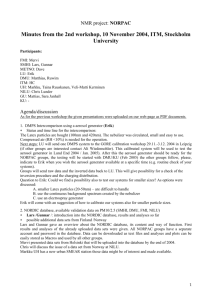

![[Skriv overskrift]](http://s3.studylib.net/store/data/005895977_1-114256512297625f47d214caed2c0634-300x300.png)



